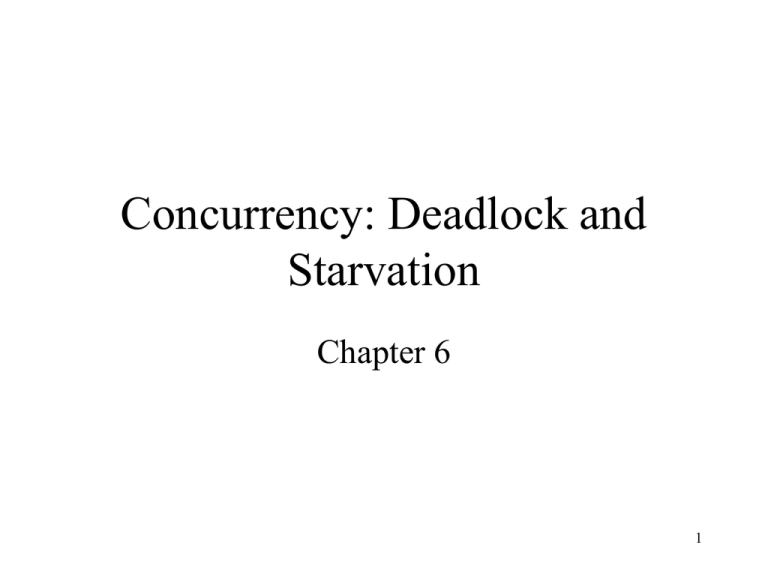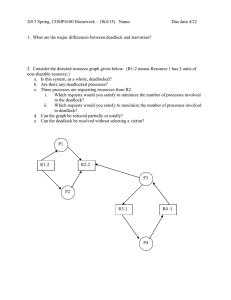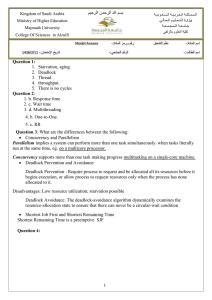Concurrency: Deadlock and Starvation Chapter 6 1
advertisement

Concurrency: Deadlock and Starvation Chapter 6 1 Deadlock • Permanent blocking of a set of processes that either compete for system resources or communicate with each other • No efficient solution • Involve conflicting needs for resources by two or more processes 2 3 4 5 Reusable Resources • Used by only one process at a time and not depleted by that use • Processes obtain resources that they later release for reuse by other processes • Processors, I/O channels, main and secondary memory, devices, and data structures such as files, databases, and semaphores • Deadlock occurs if each process holds one resource and requests the other 6 Example of Deadlock 7 Another Example of Deadlock • Space is available for allocation of 200Kbytes, and the following sequence of events occur P1 P2 ... ... Request 80 Kbytes; Request 70 Kbytes; Request 60 Kbytes; Request 80 Kbytes; ... ... • Deadlock occurs if both processes progress to their second request 8 Consumable Resources • Created (produced) and destroyed (consumed) • Interrupts, signals, messages, and information in I/O buffers • Deadlock may occur if a Receive message is blocking • May take a rare combination of events to cause deadlock 9 Example of Deadlock • Deadlock occurs if receive is blocking P1 P2 ... ... Receive(P2); Receive(P1); ... ... Send(P2, M1); Send(P1, M2); 10 Resource Allocation Graphs • Directed graph that depicts a state of the system of resources and processes 11 Resource Allocation Graphs 12 Conditions for Deadlock • Mutual exclusion – Only one process may use a resource at a time • Hold-and-wait – A process may hold allocated resources while awaiting assignment of others • No preemption – No resource can be forcibly removed form a process holding it 13 Conditions for Deadlock • Circular wait – A closed chain of processes exists, such that each process holds at least one resource needed by the next process in the chain 14 15 Possibility of Deadlock • Mutual Exclusion • No preemption • Hold and wait 16 Existence of Deadlock • • • • Mutual Exclusion No preemption Hold and wait Circular wait 17 Deadlock Prevention • Mutual Exclusion – Must be supported by the operating system • Hold and Wait – Require a process request all of its required resources at one time 18 Deadlock Prevention • No Preemption – Process must release resource and request again – Operating system may preempt a process to require it releases its resources • Circular Wait – Define a linear ordering of resource types 19 Deadlock Avoidance • A decision is made dynamically whether the current resource allocation request will, if granted, potentially lead to a deadlock • Requires knowledge of future process request 20 Two Approaches to Deadlock Avoidance • Do not start a process if its demands might lead to deadlock • Do not grant an incremental resource request to a process if this allocation might lead to deadlock 21 Resource Allocation Denial • Referred to as the banker’s algorithm • State of the system is the current allocation of resources to process • Safe state is where there is at least one sequence that does not result in deadlock • Unsafe state is a state that is not safe 22 Determination of a Safe State Initial State 23 Determination of a Safe State P2 Runs to Completion 24 Determination of a Safe State P1 Runs to Completion 25 Determination of a Safe State P3 Runs to Completion 26 Determination of an Unsafe State 27 Determination of an Unsafe State 28 Deadlock Avoidance Logic 29 Deadlock Avoidance Logic 30 Deadlock Avoidance • Maximum resource requirement must be stated in advance • Processes under consideration must be independent; no synchronization requirements • There must be a fixed number of resources to allocate • No process may exit while holding resources 31 Deadlock Detection 32 Strategies once Deadlock Detected • Abort all deadlocked processes • Back up each deadlocked process to some previously defined checkpoint, and restart all process – Original deadlock may occur • Successively abort deadlocked processes until deadlock no longer exists • Successively preempt resources until deadlock no longer exists 33 Selection Criteria Deadlocked Processes • Least amount of processor time consumed so far • Least number of lines of output produced so far • Most estimated time remaining • Least total resources allocated so far • Lowest priority 34 Strengths and Weaknesses of the Strategies 35 Dining Philosophers Problem 36 Dining Philosophers Problem 37 Dining Philosophers Problem 38 Dining Philosophers Problem 39 Dining Philosophers Problem 40 UNIX Concurrency Mechanisms • • • • • Pipes Messages Shared memory Semaphores Signals 41 42 Linux Kernel Concurrency Mechanisms • Includes all the mechanisms found in UNIX • Atomic operations execute without interruption and without interference 43 Linux Atomic Operations 44 Linux Atomic Operations 45 Linux Kernel Concurrency Mechanisms • Spinlocks – Used for protecting a critical section 46 47 Linux Kernel Concurrency Mechanisms 48 Solaris Thread Synchronization Primitives • Mutual exclusion (mutex) locks • Semaphores • Multiple readers, single writer (readers/writer) locks • Condition variables 49 50 51


